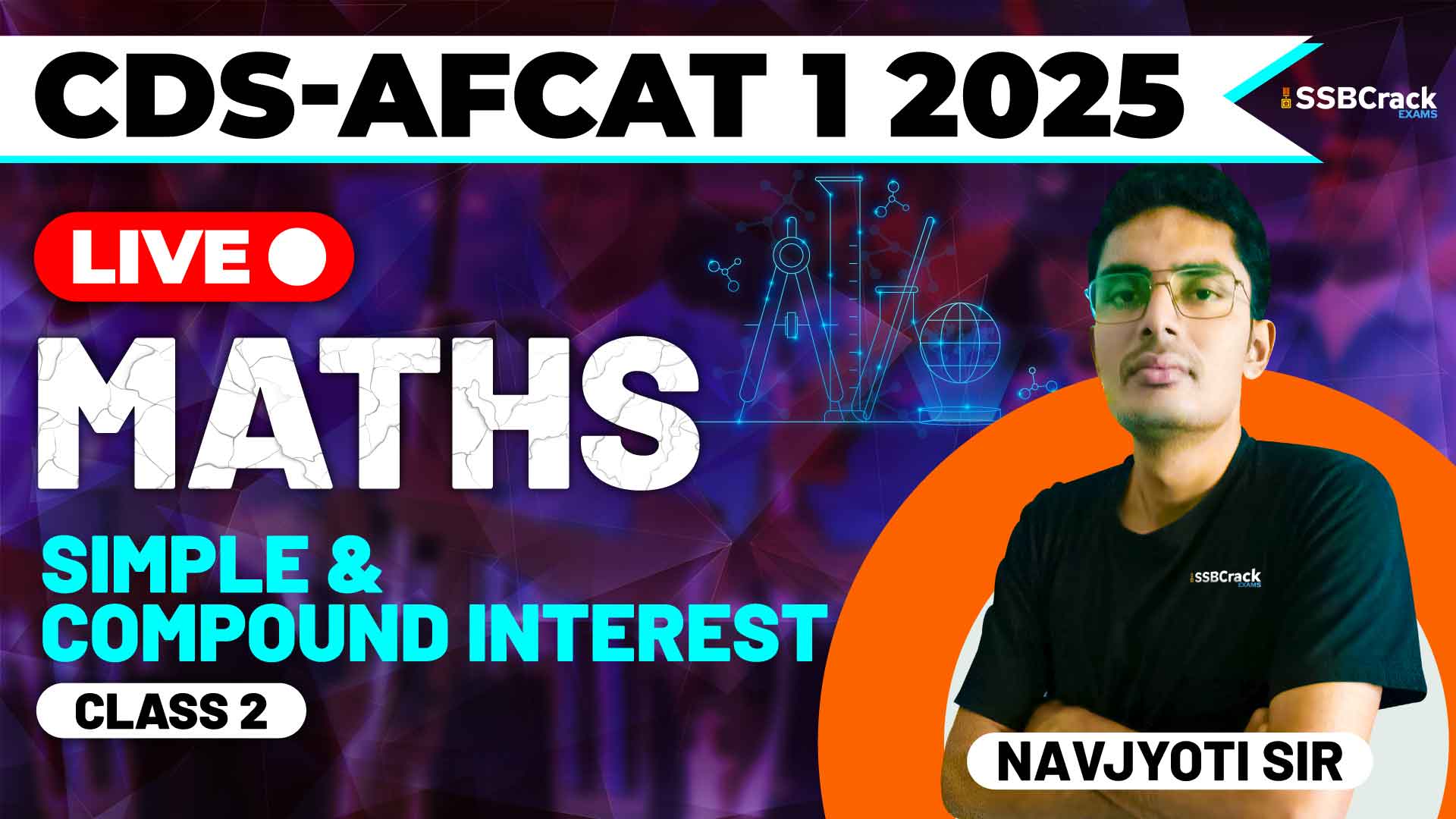In competitive exams like the Combined Defence Services (CDS) and Air Force Common Admission Test (AFCAT), understanding concepts such as Simple Interest (SI) and Compound Interest (CI) is critical to scoring well in the mathematics section. A recent class focused on advanced concepts related to Compound Interest, including its formula, how it differs from Simple Interest over two and three years, installment payments, and interest calculations when compounded half-yearly or quarterly.
This blog will provide an overview of these topics as explained in the class, along with essential strategies to help candidates prepare efficiently for questions related to Simple and Compound Interest in the CDS and AFCAT exams.
Key Concepts Discussed in the Class
1. Compound Interest (CI)
Compound Interest is the interest calculated on both the initial principal and the accumulated interest from previous periods. This results in “interest on interest,” meaning the amount grows at a faster rate compared to Simple Interest. Compound Interest problems in exams usually require candidates to calculate how much money grows over time when interest is compounded annually, semi-annually (half-yearly), or quarterly.
- Compounding Frequency:
One of the significant concepts explained in the class was how the frequency of compounding affects the total interest earned. The compounding period can be: - Annually (once a year)
- Semi-annually (twice a year)
- Quarterly (four times a year)
The compounding frequency impacts how often the interest is added to the principal, which directly affects the final amount. Understanding how to adjust interest calculations based on different compounding periods is crucial.
2. Compound Interest Formula
The standard formula for Compound Interest was discussed, and it forms the backbone of many exam questions. The class explained how to modify this formula depending on the compounding period. When the interest is compounded more frequently, the total amount increases due to the effect of compounding.
3. Compound Interest Compounded Half-Yearly and Quarterly
In many exam questions, interest may be compounded more than once a year. Understanding how to adjust the formula for semi-annual and quarterly compounding is key. When compounded semi-annually, the interest rate is halved, but the number of compounding periods is doubled. Similarly, for quarterly compounding, the rate is divided by four, and the number of periods is multiplied by four. This concept was thoroughly discussed, with practical examples to show how it affects the total amount.
4. Installments
Another important sub-topic covered was the installment method. Candidates may be asked to calculate equal installments required to pay off a loan over a specific period with compound interest applied. Understanding the calculation of regular payments or installments based on a loan amount, interest rate, and time period is essential for tackling these questions. Installments can appear in real-life scenarios, and candidates must be comfortable with solving for them using various time frames.
5. Difference Between CI and SI for Two and Three Years
In exam questions, students are often asked to find the difference between Compound Interest and Simple Interest over two or three years. While SI remains constant across time, CI increases as interest is added to the principal. Over multiple years, this difference becomes more pronounced.
In the class, special attention was given to this difference, explaining that while for one year the difference between SI and CI is negligible, over two or more years, the compounded nature of CI causes a divergence. Understanding how to calculate this difference for two and three years is essential for solving these types of problems.
Essential Strategies for Preparing for CDS and AFCAT Exams
Understanding the theoretical concepts behind Simple and Compound Interest is only half the battle. Here are some strategies to help you effectively prepare for the exam questions on these topics:
1. Master the Basics First
Before tackling advanced problems like compounded interest for different periods or installment calculations, ensure you have a solid grasp of the fundamental concepts. Start by fully understanding the relationship between principal, interest rate, time, and interest. Knowing how these variables interact will allow you to approach more complex problems with confidence.
2. Practice Questions on Compounded Interest
Once you’re comfortable with basic interest calculations, move on to practice questions involving different compounding frequencies. These are more common in competitive exams as they test your ability to modify formulas and adjust for half-yearly or quarterly periods. Focus on mastering how to handle changes in compounding frequency, as this is a frequent area of confusion for many students.
3. Focus on Installment-Based Problems
Installment questions often appear in the CDS and AFCAT exams. These can be tricky since they involve both interest calculations and regular payments spread over time. Practice solving problems where you need to calculate equal installments for loan repayment over a specified period. Focus on understanding how the interest rate and compounding affect the payment schedule.
4. Understand the SI-CI Difference Over Time
Many CDS and AFCAT exam questions ask you to calculate the difference between SI and CI over two or three years. Ensure you can handle this type of question by practicing problems where you compare the results of both Simple and Compound Interest for multiple time periods. Remember, while the SI remains the same each year, CI accumulates faster, and understanding this difference will help you solve questions quickly.
5. Solve Previous Years’ Papers
Solving past exam papers gives you an idea of the types of questions typically asked in CDS and AFCAT exams. Focus on questions related to SI and CI from these papers to gauge the difficulty level and common patterns. This will also help you familiarize yourself with the time pressure of the actual exam.
6. Develop Speed and Accuracy
Time management is crucial in competitive exams. Compound Interest questions can be time-consuming, especially those involving different compounding periods or installments. Practice under timed conditions to ensure you can solve these questions quickly without making errors. Work on shortcuts and methods to simplify calculations, such as breaking down the problem into smaller steps or using mental math for intermediate steps.
7. Memorize Key Formulas and Understand Their Application
While memorizing formulas is important, understanding when and how to apply them is equally crucial. Many exam questions involve subtle variations, such as different compounding periods, that require adjustments to the basic formula. Knowing how to tweak the formula based on the problem will help you solve questions faster and more accurately.
Conclusion
The topics of Simple and Compound Interest are essential for any candidate preparing for the CDS and AFCAT exams. While Simple Interest calculations are straightforward, Compound Interest introduces complexities such as multiple compounding periods and installment payments, which require a deeper understanding of the underlying principles. The recent class highlighted how to handle these complexities, with special emphasis on understanding compounded interest for half-yearly and quarterly periods, installment calculations, and the difference between SI and CI over two or three years.
By mastering the fundamental concepts, practicing various types of interest problems, and using the right strategies for speed and accuracy, you can tackle these questions with confidence in your exams. The key is to stay consistent with your practice and focus on understanding the logic behind the formulas rather than just memorizing them. With the right approach, you’ll be well-prepared to score well in the interest-related questions in your CDS and AFCAT exams.
Good luck!



















